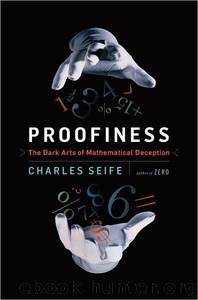Proofiness by Charles Seife

Author:Charles Seife
Language: eng
Format: mobi, epub
Tags: Science, Politics, Psychology, Non-fiction
ISBN: 9781101443507
Publisher: Penguin Group (USA)
Published: 2010-09-01T00:00:00+00:00
A close election is the ideal breeding ground for proofiness of all kinds. When lawyers declared that the fluctuating vote totals in the Minnesota election were “statistically dubious”—implying that they were the product of electoral fraud—they were using randumbness to generate phony plots and conspiracies. Partisans on both sides also cherry-pick data that is favorable to the press, all the while trying to bury data that is unfavorable. For example, one oft-repeated tidbit that echoed through the press in January: “In twenty-five precincts, most of them Franken precincts, there were more votes cast than showed up at the polls.” In fact, the number was closer to seven hundred precincts, and plenty of them favored Coleman—quite a significant omission.64 These sorts of randumbness and cherry-picking are sins of spin; they foment discontent and try to undermine support for an opponent. They’re nasty and they’re dishonest, but they’re not the worst of what’s going on.
In a close election, one particular kind of proofiness, shared by Democrats and Republicans alike, is responsible for the worst lies in Coleman v. Franken as well as Bush v. Gore. And this form of proofiness all but guaranteed that these close elections would be decided the wrong way. As indeed they were. Only by ridding ourselves of it can we finally see who should have won the Minnesota election—or whether Bush should have ever been made president. That form of proofiness is disestimation.
Disestimation is the root of all the evils that came from the 2000 presidential election as well as the 2008 Minnesota Senate election. As long as there are close elections, disestimation will continue to exact a toll year after year, obscuring the truth. However, once you recognize the problem and see through the fog of disestimation, it becomes crystal clear how these elections should have been decided.
The first step is simply to admit that elections are measurements and are therefore fallible. Even under ideal conditions, even when officials count well-designed ballots with incredible deliberation, there are errors on the order of a few hundredths of a percent. And that’s just the beginning. There are plenty of other errors in any election. There are errors caused by people entering data incorrectly. There are errors created by people filling out ballots wrong, casting their vote for the wrong person. There are errors caused by absentee ballots that are wrongly excluded from the count, or illegal ballots that somehow make it into the mix. Ballots will be misplaced. Ballots will be double-counted. All of these errors make it harder to determine the truth of who really won an election.
Everybody knows about these errors, at least on some level. In Bush v. Gore the Court commented on how the dispute “brought into sharp focus a common, if heretofore unnoticed phenomenon”65 that the process of counting ballots was error-prone. Yet almost everybody completely ignores these errors. This is disestimation.
When the Minnesota secretary of state announced that Barack Obama got 1,573,354 votes and John McCain got 1,275,409 votes in the 2008 election, it was a case of disestimation.
Download
This site does not store any files on its server. We only index and link to content provided by other sites. Please contact the content providers to delete copyright contents if any and email us, we'll remove relevant links or contents immediately.
| Algebra | Calculus |
| Combinatorics | Discrete Mathematics |
| Finite Mathematics | Fractals |
| Functional Analysis | Group Theory |
| Logic | Number Theory |
| Set Theory |
Modelling of Convective Heat and Mass Transfer in Rotating Flows by Igor V. Shevchuk(6408)
Weapons of Math Destruction by Cathy O'Neil(6221)
Factfulness: Ten Reasons We're Wrong About the World – and Why Things Are Better Than You Think by Hans Rosling(4718)
A Mind For Numbers: How to Excel at Math and Science (Even If You Flunked Algebra) by Barbara Oakley(3262)
Descartes' Error by Antonio Damasio(3250)
Factfulness_Ten Reasons We're Wrong About the World_and Why Things Are Better Than You Think by Hans Rosling(3218)
TCP IP by Todd Lammle(3158)
Fooled by Randomness: The Hidden Role of Chance in Life and in the Markets by Nassim Nicholas Taleb(3083)
Applied Predictive Modeling by Max Kuhn & Kjell Johnson(3043)
The Tyranny of Metrics by Jerry Z. Muller(3034)
The Book of Numbers by Peter Bentley(2935)
The Great Unknown by Marcus du Sautoy(2666)
Once Upon an Algorithm by Martin Erwig(2627)
Easy Algebra Step-by-Step by Sandra Luna McCune(2607)
Lady Luck by Kristen Ashley(2556)
Police Exams Prep 2018-2019 by Kaplan Test Prep(2518)
Practical Guide To Principal Component Methods in R (Multivariate Analysis Book 2) by Alboukadel Kassambara(2516)
All Things Reconsidered by Bill Thompson III(2374)
Linear Time-Invariant Systems, Behaviors and Modules by Ulrich Oberst & Martin Scheicher & Ingrid Scheicher(2348)
